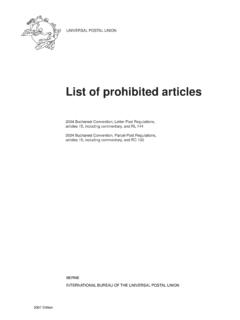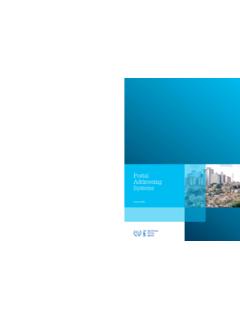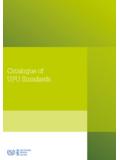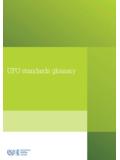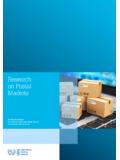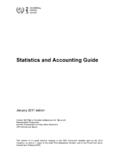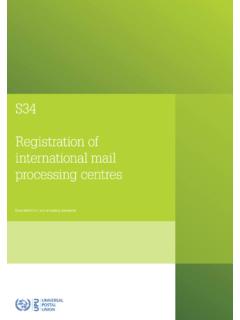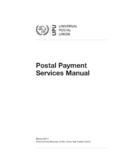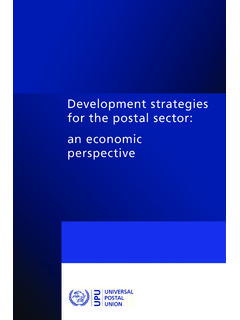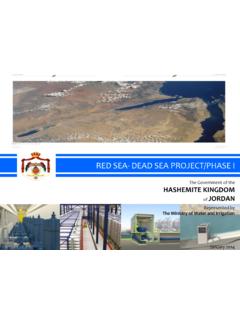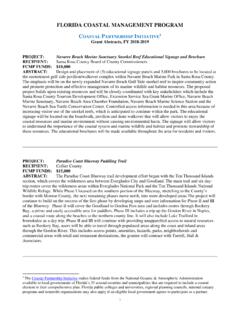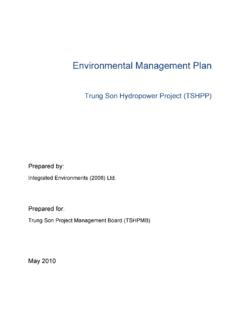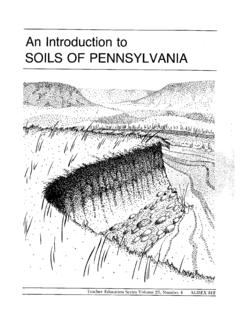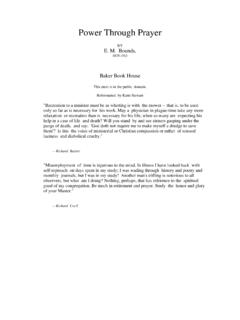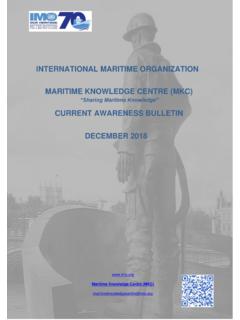Transcription of Report of the seminar management for the postal sector in ...
1 1 Par Jos Ans nDirection des affairs conomiques Report of the seminar on disaster risk management for the postal sector in the Asia-Pacific regionDATE: 19 and 20 January 2016 VENUE: Asian-Pacific postal College, Bangkok, Thailand3 Message from Mr Bishar A. Hussein, UPU Director General: During the 2013 2016 cycle, the number and intensity of large-scale disasters has increased, resulting in more human casualties and economic damage, also affecting the postal sector . But the Post can be a key player in disaster response, for example, by serving as a distribution point for emergency supplies and money transfers in the affected areas, and by providing a basic means of communication when no other system is available. During the 2013 2016 cycle, the UPU has made numerous efforts to raise awareness, set a framework for the UPU DRM activities and provide a platform for exchanges of best practices. DRM is a rather new activity for the UPU, but it has gained momentum and is now an integral component of our development cooperation policy.
2 This seminar is an example of the concrete actions being implemented by the UPU to meet this objective. In the coming years, the UPU will continue to promote DRM in the postal sector by integrating DRM principles and objectives into UPU development cooperation frameworks and projects, especially at regional level. Mr Olivier Boussard, Coordinator, UPU IBReport of the seminar on disaster risk management for the postal sector in the Asia-Pacific regionOpening Session (Moderator: Olivier Boussard)DATE: 19 and 20 January 2016 VENUE: Asian-Pacific postal College, Bangkok, ThailandPARTICIPANTS: 44 representatives from 16 UPU member countries (Afghanistan, Bangladesh, Bhutan, Cambodia, Japan, Korea (Rep.), Lao People s Dem. Rep., Malaysia, Myanmar, Nepal, Pakistan, Philippines, Samoa, Thailand, United States of America, Viet Nam), and experts from APPU, ESCAP, WMO and UPU IB for a total of 51 Disasters affect the postal sector and operators ability to conduct business and serve their customers.
3 Histori-cally, the UPU has played an important role in assisting in the response to the effects of natural disasters on Posts. Because disasters will continue to happen, any steps that can be taken to prepare Posts and make the sec-tor more resilient will be an investment in our future. The Asia-Pacific region has been hit hard by natural disasters, having the largest share of the world s recent disasters. We can learn from the experiences of the re-gion s member countries and postal operators on how to prepare for and respond to disasters. It is critically important for all parties to work together to ensure the resilience of the postal sector . The UNDP likes to note that each dollar invested in disaster preparedness saves seven dollars in response ; that is why DRM is critically important for the postal sector as a whole, and for UPU designated Mr Patrick Mendonca, Senior Director, Office of the Postmaster General, United States postal Service ( ), Chair of the UPU Ad Hoc Group on Mr Lin Hongliang, Director, APPU The Asia-Pacific region has suffered frequent natural disasters.
4 On the one hand, natural disasters destroy postal facilities and infrastructure and cause deaths among postal staff. On the other hand, in some cases, the Post is the single channel for local people to com-municate just after disasters. So it is very important to help and support Posts during and after disasters. This seminar is a great opportunity to share best practices from experts of the various organizations. Building disaster-resilient postal services on a global scale through disaster risk reduction (DRR) projects matches the spirit of the UPU to promote communi-cation among peoples and contribute to international cultural, social and economic cooperation. The UPU DRM project was launched when Japan s proposal was approved at the 2012 UPU Doha Congress. The project aims to build disaster-resilient postal services at a global level by sharing technologies, know-how and lessons learned. Japan s active involvement in addressing the issue is very beneficial not only to increase the value of the postal networks in the region, but also to discuss further improvement of our individual domestic measures.
5 Japan intends to continue its contribution in this field in the cycles after the Istanbul Mr Hiroshi Nakayama, Director, International Affairs Office, Ministry of Internal Affairs and Communications (Japan)5tive to support the implementation of the Sustainable Development Goals (SDGs), with the aim of facilitating the movement of people, goods, money, information and knowledge for sustainable socio-economic devel-opment in the region. Disaster response is critical for the UN s 2030 Sustainable Development Agenda agreed to in August 2015: 1. Many countries need to follow a consistent and coherent approach to address disasters, with the focus on response to be accompanied by International assistance needs to go beyond emergency response to risk preparedness, preven-tion and Efforts to strengthen resilience are effective only when integrated into overall strategies for sustain-able Just as every sector can be affected by disasters, so every sector needs to consider how to make its activities Regional cooperation is critical to addressing disas-ters in Asia and the Asia-Pacific cannot achieve the SDGs without building resilience to Situation in the region: 2015 Report (UN ESCAP).
6 Dr Sanjay Srivastava, Chief of the Disaster Risk Reduction Section, Information and Communications Technology and Disaster Risk Reduction Division Between 2005 and 2014, 40% of global disasters, 60% of global deaths, 80% of global affected people and 45% of global economic damage occurred in the Asia-Pacific region. The Asia-Pacific Information Super Highway is the regional broadband network under the ESCAP initia-Session 1: Asia-Pacific and natural disasters (Moderator: Patrick Mendonca)dead). Economic loss was billion USD, and GDP growth decreased from + to After the flood in 2011, the Thai government learned many lessons, including: Deforestation was main cause of flooding Effective flood risk management requires collaboration and engagement among various stakeholders Data and information accessibility was not unified Structure countermeasures Build fundamental knowledge for disaster preparedness before next incident Financial incentive ( tax reduction) for recovery Based on these lessons learned, the Thai government established a new National DRM Plan in 2015 with four DRM plan in Thailand and case study of flood in 2011 (Department of Disaster Prevention, Ministry of Interior of Thailand).
7 Mr Chainarong Vasanasomsithi, Director, Research and International Cooperation Bureau Thai government enacted Disaster Prevention and Mit-igation Act in 2007 and has established the National Disaster Prevention and Mitigation Plan, which is a na-tional framework for all sectors to carry out their roles and responsibilities in the areas of DRR and DRM. Flood in 2011 affected wide areas of Thailand (65 provinces): million people affected (813 people 64. Enhance international cooperation on DRM since disaster is trans-boundary in nature. The Thai government will also make efforts to enhance international cooperation in four areas:1. Ensuring unified humanitarian coordination system2. Standardizing humanitarian operation procedure3. Enabling learning environment for DRM4. Promoting Thailand s leadership in DRR1. Reduce disaster risks: prevent and prepare for identified and projected risks through multi-hazard risk assessment with structural and non-structural Enhance effectiveness of integrated emergency management ;3.)
8 Enhance inclusive relief, reconstruction and reha-bilitation programme with build back better affected by devastating cyclones multiple times in the last few decades, such as Cyclone Ofa in 1990 and Cyclone Val in 1991. Cyclones are associated with damaging winds, rainfall, flooding, swells, etc. Samoa Post built post offices with the ground floor several steps higher than sea level to prevent damage to postal items and equipment Japan presented how it responded to this disaster:1. Initial response Gathering information Confirmation of damages, including safety of employees, damage of POs, etc. Establishment of Disaster Response HQ and Local Response HQ Announcement of information on the status of services and mail delivery on the website2. Service restoration activities Send support staff to affected POs Identify required equipment to resume services Installation of portable toilets Recovery operations (control traffic of mail, co-ordinate another shipment route, secure vehicles to deliver, determine priority services to recover such as express and parcel services) Deliver mail items to evacuation Samoa Post: Mr Theodore McFarland, Assistant Clerk Samoa is ranked 30th of countries most exposed to three or more hazards.
9 Samoa is at high risk of natural disasters, especially cyclones and floods. Samoa has Japan Post: Mr Toshihide Suzuki, Senior Manager, Risk management Office In September 2015, Typhoon Etau (referred to as Ty-phoon No. 18 in 2015 in Japan) caused record-break-ing rainfall and floods, and 33 post offices were affected and obliged to 2: Recent natural disasters and postal services in the Asia-Pacific region (moderator: Patrick Mendonca)7cooperation with memorandum of understand-ing between POs and local governments Criteria for deciding to resume services at POs under an evacuation order were unclear: deci-sion should be made faster, in coordination with postmasters in the affected area3. Lessons learned and future measures Call tree did not work well: familiarize employ-ees with the emergency contact procedures Japan Post could not get information on the refugees at the evacuation site from the local government for reasons of privacy protection, which caused delivery delays: enhanced mutual Nearly 9,000 people were killed by the earthquake in April and May 2015, and total property loss was over 5 billion USD.
10 Nepal Post also lost approximately million USD. Currently, the UPU and Nepal Post are carrying out an emergency assistance project for recovery. Lessons learned: Before earthquake: anti-seismic building, relocation of POs away from earthquake- sensi-tive spots, preparation of first aid kit and food, training on how to protect oneself, placing of important items at a safe place, etc. During earthquake: don t panic, stop vehicles, protect oneself, etc. After earthquake: Prepare for aftershocks, stop gas and electricity services, ensure safety of family, don t use telephones to leave lines free for emergency use by the authorities, etc. There are many disasters in Pakistan; at the earthquake in 2005, 730,000 were killed. At Pakistan Post, two postmasters were killed and 92 post offices totally destroyed. Floods also hit the country, but most post offices have been relocated and act as a hub for security. Pakistan has a disaster risk reduction and recovery plan (DRRP). Only thing to do is identify how to minimize the damage and how to adapt plan afterwards.

